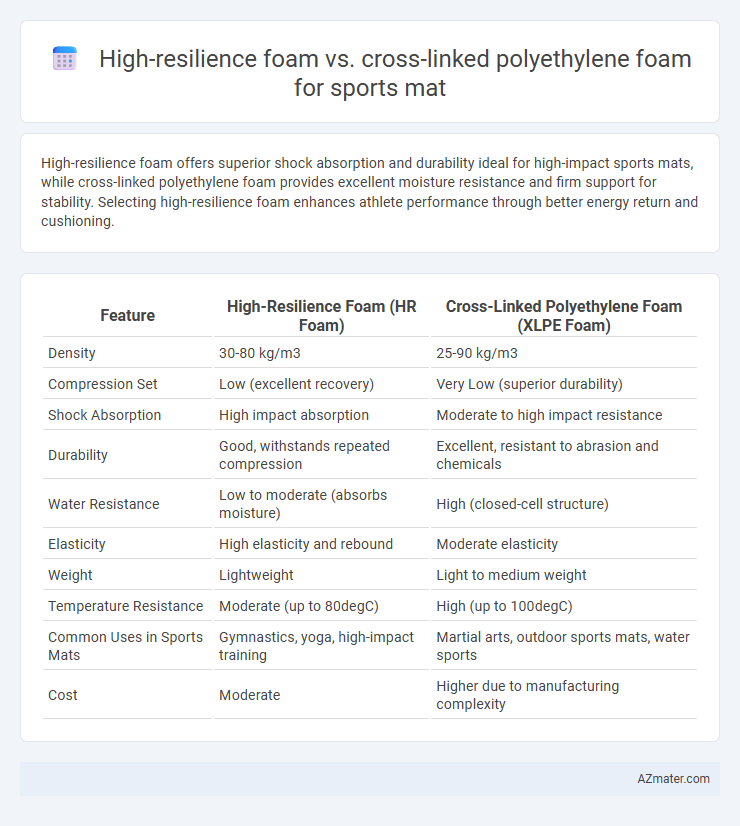High-resilience foam offers superior shock absorption and durability ideal for high-impact sports mats, while cross-linked polyethylene foam provides excellent moisture resistance and firm support for stability. Selecting high-resilience foam enhances athlete performance through better energy return and cushioning.
Table of Comparison
| Feature | High-Resilience Foam (HR Foam) | Cross-Linked Polyethylene Foam (XLPE Foam) |
|---|---|---|
| Density | 30-80 kg/m3 | 25-90 kg/m3 |
| Compression Set | Low (excellent recovery) | Very Low (superior durability) |
| Shock Absorption | High impact absorption | Moderate to high impact resistance |
| Durability | Good, withstands repeated compression | Excellent, resistant to abrasion and chemicals |
| Water Resistance | Low to moderate (absorbs moisture) | High (closed-cell structure) |
| Elasticity | High elasticity and rebound | Moderate elasticity |
| Weight | Lightweight | Light to medium weight |
| Temperature Resistance | Moderate (up to 80degC) | High (up to 100degC) |
| Common Uses in Sports Mats | Gymnastics, yoga, high-impact training | Martial arts, outdoor sports mats, water sports |
| Cost | Moderate | Higher due to manufacturing complexity |
Introduction to Sports Mat Foam Materials
High-resilience foam offers superior cushioning and energy return, making it ideal for sports mats that demand durability and shock absorption. Cross-linked polyethylene foam provides excellent water resistance and long-lasting structural integrity, ensuring reliable performance in high-impact and moisture-prone environments. Both materials balance comfort and protection, with HR foam excelling in flexibility and XLPE foam standing out for its toughness and moisture resilience.
What is High-Resilience (HR) Foam?
High-Resilience (HR) foam is a type of polyurethane foam known for its superior elasticity and durability, making it ideal for sports mats that require high impact absorption and long-lasting performance. Compared to Cross-linked polyethylene foam, HR foam offers enhanced rebound properties and better resistance to wear, providing superior comfort and support during athletic activities. Its open-cell structure allows for improved breathability and moisture management, contributing to a safer and more hygienic sports environment.
What is Cross-Linked Polyethylene (XLPE) Foam?
Cross-Linked Polyethylene (XLPE) foam is a durable, closed-cell foam known for its superior cushioning and resistance to impact, making it ideal for sports mats. Its cross-linked polymer structure enhances thermal stability and compressive strength, providing excellent shock absorption and long-term resilience. Compared to high-resilience foam, XLPE foam offers better moisture resistance and durability under continuous use in athletic environments.
Shock Absorption Comparison: HR Foam vs XLPE Foam
High-resilience (HR) foam offers superior shock absorption due to its open-cell structure, which effectively disperses impact forces and enhances cushioning for sports mats. Cross-linked polyethylene (XLPE) foam, with its closed-cell composition, provides firmer support but absorbs less energy upon impact compared to HR foam, making it less effective for high-impact shock mitigation. HR foam's enhanced elasticity and rapid recovery rate contribute to better protection against repetitive shocks, ideal for intense athletic activities.
Durability and Lifespan Analysis
High-resilience foam offers superior durability for sports mats due to its open-cell structure that rapidly recovers its shape after compression, extending lifespan in high-impact activities. Cross-linked polyethylene foam features a closed-cell configuration, providing excellent resistance to moisture and physical wear, which enhances longevity in outdoor or humid environments. When analyzing lifespan, high-resilience foam typically retains cushioning properties longer in dynamic sports use, while cross-linked polyethylene foam excels in maintaining structural integrity under sustained pressure and environmental stress.
Comfort and User Experience
High-resilience foam offers superior cushioning and enhanced durability, providing athletes with optimal shock absorption and long-lasting comfort during intense workouts on sports mats. Cross-linked polyethylene foam delivers firm support with excellent water resistance and quick recovery, making it ideal for activities requiring stability and durability. The choice between the two depends on the need for softness and energy return versus firmness and moisture resistance, directly impacting user experience and performance.
Moisture Resistance and Hygiene
High-resilience foam offers moderate moisture resistance but can absorb sweat and require frequent cleaning to maintain hygiene. Cross-linked polyethylene foam provides superior moisture resistance due to its closed-cell structure, preventing water and bacteria infiltration and making it ideal for sports mats in humid environments. Its non-absorbent nature enhances sanitation and reduces odor retention, supporting better hygiene standards during intense physical activities.
Weight and Portability
High-resilience foam sports mats excel in lightweight properties, making them highly portable for activities requiring frequent transportation. Cross-linked polyethylene foam, while slightly heavier, provides enhanced durability and impact absorption, which may affect ease of carrying. Choosing between the two depends on prioritizing either minimal weight for portability or increased cushioning for protection during sports.
Cost Effectiveness: HR vs XLPE Foam
High-resilience (HR) foam offers superior durability and cushioning for sports mats but generally comes at a higher price point compared to cross-linked polyethylene (XLPE) foam. XLPE foam provides cost-effective shock absorption and resilience, making it ideal for budget-conscious sports facilities seeking adequate performance with lower upfront investment. When evaluating cost effectiveness, XLPE foam delivers better value for frequent replacement scenarios, while HR foam is preferable for long-term use where durability justifies the initial expense.
Best Applications: Choosing the Right Foam for Your Sport
High-resilience foam offers superior energy return and durability, making it ideal for high-impact sports like basketball and gymnastics where shock absorption and cushioning are critical. Cross-linked polyethylene foam provides excellent water resistance and firmness, suitable for aquatic sports, yoga mats, and fitness areas requiring stable support and moisture control. Selecting the right foam depends on the sport's specific demands for comfort, resilience, and environmental factors to optimize athlete performance and safety.

Infographic: High-resilience foam vs Cross-linked polyethylene foam for Sports mat
 azmater.com
azmater.com